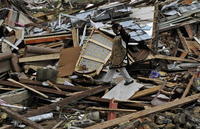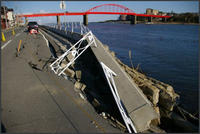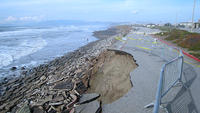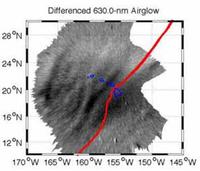-
Illinois cracks down on "storm chasers"
In response to the series of severe storms and floods that struck Illinois, Governor Pat Quinn signed legislation to help protect homeowners as they rebuild; House Bill 3034 is aimed at protecting homeowners from “storm chasers,” contractors who take advantage of unsuspecting homeowners
-
-
Disasters take toll on PartnerRe’s profits
On Monday PartnerRe Ltd., the international reinsurer, announced that its second quarter earnings fell 35 percent as a result of the devastating natural disasters that struck around the world
-
-
USDA declares twenty disaster zones in California
On Monday the U.S. Department of Agriculture (USDA) designated twenty counties across California as natural disaster areas, qualifying residents for federal assistance; severe weather in these areas resulted in large losses to this season’s sweet cherry and wine grape crops
-
-
Improved engineering to protect structures on storm’s edge

In the wake of the horrendous tornadoes that delivered massive destruction to Alabama in April, University of Alabama engineers have analyzed building structures and design codes to recommend an approach to safer and stronger buildings going forward
-
-
How smartphones are fighting floods
A new smartphone app is helping the Army Corps of Engineers to strengthen its levees and fight floods in Kansas;filing reports is as simple as using a smartphone to take a picture, adding a note, and uploading the information to a database, which only takes a few seconds; this new system helps reduce the time it takes to gather critical information about levees by as much as thirty-six hours, giving engineers valuable additional time to detect and save a failing levee
-
-
U.S. General: troops unprepared for nuke risks in Japan
A U.S. general admitted that U.S. troops stationed in Japan did not have the proper training or equipment to handle radiation exposure in the days immediately following the nuclear crisis at the Fukushima Daiichi power plant caused by the 11 March earthquake and tsunami
-
-
Earthquakes: scientists will shake 5-story building in Japan
Landmark earthquake engineering tests this summer in Japan could open the door for earthquake-proofing technology applied to hospitals, nuclear power plants, and emergency-response facilities to be more common in the United States, and confirm the capabilities for the technology used in Japan and the rest of the world
-
-
Two Kiwi goldfish survive without food for more than four months

Workers returning to a downtown office in Christchurch, New Zealand, discover goldfish alive in their tank at the office; the goldfish have not been fed since the February floods forced the evacuation of the town; fish expert theorize that bacteria kept the water in the tank clean, and that the fish ate algae which grew on rocks in the tank
-
-
Japan halts shipments of radioactive beef
The Japanese government is coming under fire for only halting shipments of contaminated cattle now, four months after the 11 March earthquake and tsunami that led to the nuclear crisis at the Fukushima Daiichi atomic energy station; authorities recently discovered that 637 cattle had been fed hay contaminated with radioactive cesium and then shipped from farms in northern prefectures including Fukushima
-
-
Virginia powerplant holds nuke disaster simulation
On Tuesday, nuclear plant officials and emergency responders recently participated in an exercise to simulate an accident at the Surry atomic power plant in Virginia; Dominion Virginia Power, which operates the state’s four nuclear reactors, regularly holds exercises like these at the Surry plant, but following Japan’s nuclear disaster, the exercises have become even more important
-
-
Studying the Japan quake's impact on soil will improve building design

The 11 March quake that hit Japan weakened subsurface materials by as much as 70 percent; that nonlinear response from the top layer of the Earth’s crust affected how the movement of faults deep beneath the surface was delivered to buildings, bridges, and other structures; understanding how the soil responds to powerful earthquakes could be important to engineers and architects designing future buildings to withstand the level of acceleration measured in this quake
-
-
Sensor network to provide early quake alerts
Researchers from U.S. universities are collaborating to implement a new network of seismic sensors aimed at arming communities with early earthquake detection and warning capabilities; the sensors, no bigger than a Post-it note, are part of a new phase of the Quake-Catcher Network (QCN), a project gathering detailed data to help scientists understand the earthquake process and how to mitigate against its effects
-
-
U.S. West Coast is rapidly eroding, with pace to accelerate

The stormy conditions of the 2009-10 El Nino winter eroded beaches from San Diego to Seattle to often unprecedented levels; the higher sea levels expected due to global warming, and potentially even stronger winter storms, will likely to contribute to increased rates of beach and bluff erosion along much of the U.S. West Coast
-
-
Method for early detection of tsunami found

Researchers, for the first time, have recorded an airglow signature in the upper atmosphere produced by a tsunami; the signature, caused by the 11 March earthquake that devastated Japan, was observed in an airglow layer 250 kilometers above the Earth’s surface; it preceded the tsunami by one hour, suggesting that the technology could be used as an early-warning system in the future
-
-
Japan's prime minister pushes to end nuke program
Japan could soon be following in the footsteps of Germany and shut down its nuclear energy plants; at a televised press conference on Wednesday, Prime Minister Naota Kan pushed to end Japan’s nuclear program; “Japan should aim for a society that does not depend on nuclear energy,” Kan said
-
More headlines
The long view
The Surprising Reasons Floods and Other Disasters Are Deadlier at Night
It’s not just that it’s dark and people are asleep. Urban sprawl, confirmation bias, and other factors can play a role.
Why Flash Flood Warnings Will Continue to Go Unheeded
Experts say local education and community support are key to conveying risk.
